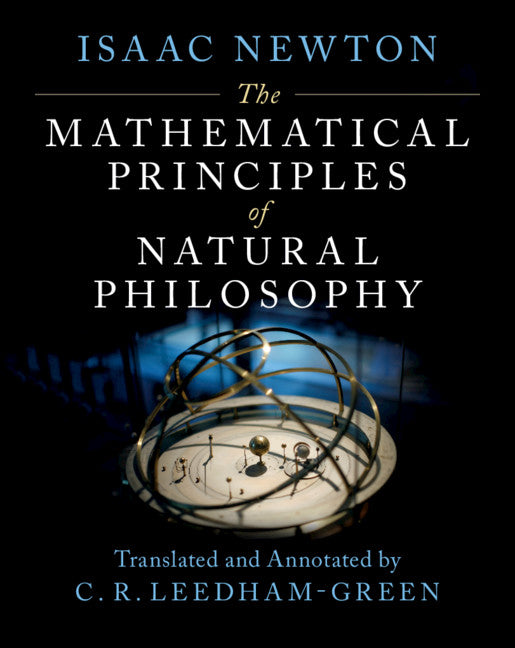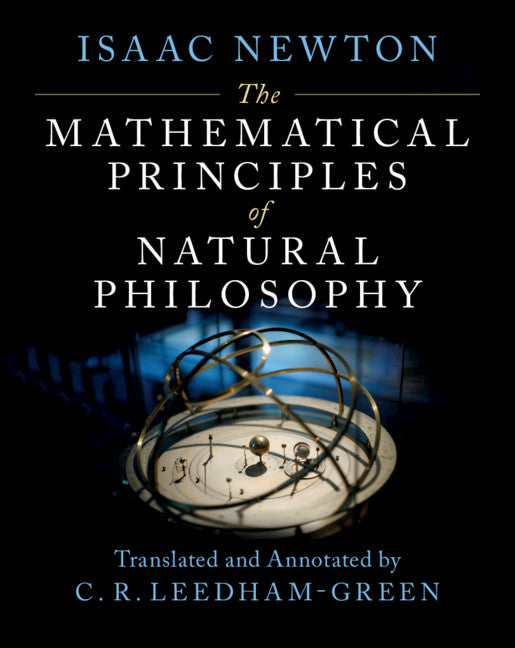Freshly Printed - allow 4 days lead
Couldn't load pickup availability
The Mathematical Principles of Natural Philosophy
Heavily annotated translation of the third and final edition (1726) of Newton's Principia, designed for easy understanding of the text.
Isaac Newton (Author), C. R. Leedham-Green (Edited and translated by)
9781107020658, Cambridge University Press
Hardback, published 4 March 2021
790 pages, 270 b/w illus. 20 tables
26 x 20.8 x 4.8 cm, 1.84 kg
Newton's Principia is perhaps the second most famous work of mathematics, after Euclid's Elements. Originally published in 1687, it gave the first systematic account of the fundamental concepts of dynamics, as well as three beautiful derivations of Newton's law of gravitation from Kepler's laws of planetary motion. As a book of great insight and ingenuity, it has raised our understanding of the power of mathematics more than any other work. This heavily annotated translation of the third and final edition (1726) of the Principia will enable any reader with a good understanding of elementary mathematics to easily grasp the meaning of the text, either from the translation itself or from the notes, and to appreciate some of its significance. All forward references are given to illuminate the structure and unity of the whole, and to clarify the parts. The mathematical prerequisites for understanding Newton's arguments are given in a brief appendix.
Definitions
The Axioms, or the Laws of Motion
On the Motion of Bodies, Book One: I.1. On the theory of limits, which is used to deduce later results
I.2. On the calculation of centripetal forces
I.3. On the motion of particles in eccentric conic sections
I.4. On the calculation of elliptical, parabolic, and hyperbolic orbits
I.5. On the calculation of orbits when neither focus is given
I.6. On the calculation of motion in given orbits
I.7. On the ascent and descent of particles in a straight line
I.8. On the calculation of the orbits in which particles revolve under any centripetal forces
I.9. On the motion of particles in moving orbits, and the motion of the apsides
I.10. On the motion of particles on given surfaces, and the swinging motion of a string pendulum
I.11. On the motion of particles attracting each other by centripetal forces
I.12. On the attractive forces of spherical bodies
I.13. On the attractive forces of non-spherical bodies
I.14. On the motion of particles attracted by centripetal forces towards the various parts of arbitrarily large bodies
On the Motion of Bodies, Book Two: II.1. On the motion of particles moving against a resistance that is proportional to the speed
II.2. On the motion of bodies moving against a resistance that is proportional to the square of the speed
III.3. On the motion of bodies to which the resistance consists of one part that is proportional to the speed, and another to the square of the speed
II.4. On the circular motion of bodies in resisting media
II.5. On the density and compression of fluids, and on hydrostatics
II.6. On the motion and resistance of string pendulums
II.7. On the motion of fluids and the resistance of projectiles
II.8. On motion propagated through fluids
II.9. On the circular motion of fluids
On Celestial Mechanics, Book Three: Introduction to Book Three
The Rules of Scientific Argument
Phenomena
Propositions
On the motion of the nodes of the moon
General Scholium
A. Mathematical notation and results assumed in The Principia
B. Calculus in The Principia
C. Newton's astronomy
D. Newton's theory of tides
E. Technical terms used in the translation
F. On Newton's style, and translating The Principia
G. Some difficult words
H. Astrological symbols
I. Glossary of Latin terms
J. Technological illustrations
References
Index.
Subject Areas: Dynamics & statics [PHDT], Physics [PH], History of science [PDX], Philosophy of science [PDA], Mathematical foundations [PBC], Mathematics [PB]


